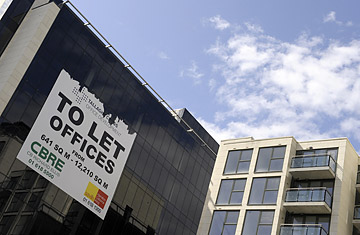
There's an eerie silence in Adamstown. Between the rows of sleek apartment buildings in this new housing development in suburban Dublin, buses meander the empty streets, searching in vain for passengers to take into the capital. On street corners, pedestrian crossing lights shine brightly, ready to guide residents through the nonexistent traffic.
Adamstown is one of scores of developments that sprang up across Ireland during the country's boom years in the late 1990s and early 2000s. Families and young professionals quickly snapped up properties in what was to be the first complete new "town" to be built in Ireland in more than 20 years. Four years after the construction started, however, the building sites in Adamstown are as quiet as the empty streets. More than 200 properties are either vacant or unfinished, and the shopping center, soccer field and swimming pool promised in the glossy advertising booklets have yet to materialize.
During the boom years, banks lent vast sums of money to developers as property fever gripped the newly wealthy nation. But when the bubble burst with the global meltdown last year, these unpaid loans left huge holes in the banks' books and the liberal lending of the Celtic Tiger era came to an abrupt halt. To steady the ship, the government placed a blanket guarantee on deposits in six Irish banks last September. At the time, according to Finance Minister Brian Lenihan, it was "the cheapest bailout in the world." But that claim soon came back to haunt him. In December it emerged that Sean Fitzpatrick, the chairman of Anglo-Irish, the country's third biggest lender, had concealed from shareholders more than $100 million in personal loans by temporarily transferring the money to a building society. Amid public outcry over the scandal, the government nationalized Anglo-Irish and recapitalized two other banks to the tune of $10.5 billion.
But even that wasn't enough. Next month, the Irish government is set to formalize a highly controversial bailout plan in which a National Asset Management Agency (NAMA) would be created to remove the unpaid, property-linked debts from the banks' balance sheets. If approved by Parliament, which appears increasingly likely, NAMA would spend some $81 billion of taxpayer money to buy loans worth an estimated $70.5 billion at current market value. The so-called bad bank, as NAMA is sometimes called, will then manage the loans on behalf of the state for the next decade, by which time, the government assumes, the country's property market will have recovered. This assumption also explains the $10.5 billion markup in the sum to be paid for the toxic assets — a difference the government says reflects the long-term economic value of the loans.
Lenihan says housing prices need only appreciate 10% over the next 10 years for NAMA to return a profit on its initial expenditure. But predicting what's around the corner is never easy — as Ireland knows only too well. According to NAMA's draft business plan, a "prolonged property market depression" or "sluggish economic growth" could result in the failure of the scheme. Despite the risks, proponents say it's the only way to ensure that Ireland's banks start lending again. But for residents bearing the brunt of the country's economic slump, NAMA is little more than an inflated bailout for the gambling debts of developers and the banks that fueled their folly.
Philip Cummins, a 26-year-old electrician, bought a three-bedroom home in Adamstown in 2007 at the peak of the property boom. Like many first-time home buyers, he took out a 100% mortgage, which he pays off in monthly installments of $2,400. In the past two years, however, his apartment has dropped in value by nearly half. To make matters worse, he lost his job three months ago and has been unable to find work since. He's by no means alone. Ireland's unemployment rate has doubled in the past year, to 12.5%, and is expected to reach 15% by 2010, with the biggest job losses coming in the construction industry. "NAMA is helping the wrong people," Cummins says. "I'll probably be evicted next year if I can't find another job, but it was the developers that got us into this mess in the first place, and they're getting off scot-free."
His neighbor Guinevere Kirk, a nurse, is also firmly opposed to NAMA. Along with the rest of Ireland's public-sector workforce, she faces a probable wage cut in December when public spending is expected to be slashed in the budget in a bid to reduce Ireland's gaping deficit. "No one even knows if [NAMA] will work because it's never been done before," she says. "All I know is that it won't be the developers or bankers who'll be feeling the pain if it all goes wrong."
Those who support NAMA say Ireland has little option but to take the plunge. The International Monetary Fund has predicted that Irish banks could lose up to $53 billion next year if they fail to get rid of their toxic assets. For Pat McCloughan, a Dublin-based economist, the looming bankruptcy threat outweighs all other concerns. "Unfortunately, developers going out of business and home repossessions are an inevitable part of [the downturn]. But a much bigger problem would be if one of the big banks was to fail. That would have massive repercussions for a small country like Ireland," he says.
Other economists aren't quite so convinced. Brian Lucey, a professor of finance at Trinity College Dublin, has been one of the most vocal critics of the scheme. "We end up with a situation where we bail out shareholders and bondholders first, then deal with taxpayers, rather than the other way round," he says. "The taxpayers are on the hook anyway. The question is, What do they get for it?"
